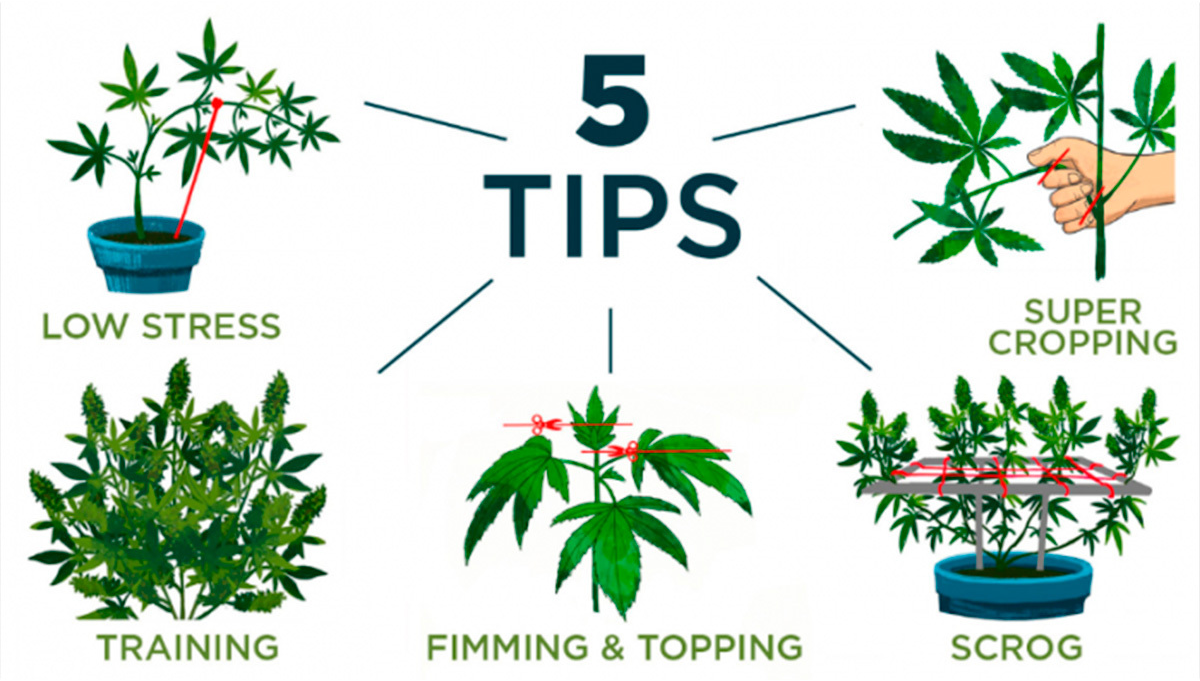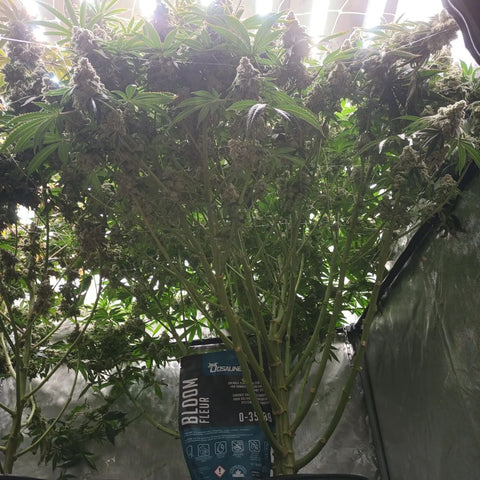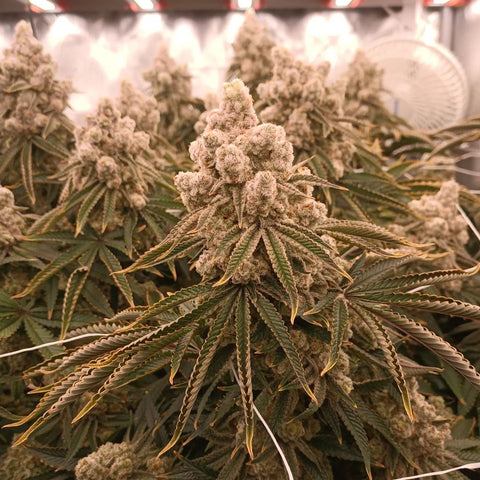How much weed does one plant yield? A Dosaline Case Study

How to Calculate Cannabis Yield
Yield calculation isn't just about the final weight of the dried buds; it's about efficiency and optimization. These calculations provide valuable insights, guiding decisions on space utilization, lighting setup, and overall energy consumption, ultimately leading to a more productive and sustainable growing operation.
Calculation Methods
Grams Per Square Foot: This method evaluates the efficiency of your space. You calculate it by dividing the total dry weight of your harvest by the square footage of your grow area. It’s a great metric for techniques like Sea of Green (SoG) or Screen of Green (ScroG), where maximizing space is key.
Grams Per Cubic Foot (g/ft³):
Taking the efficiency assessment up a dimension, this formula incorporates the height of your grow space, offering a volumetric perspective. Calculate this by dividing your total dry weight by the cubic footage of your canopy. This metric shines a light on the potential of vertical grow spaces and the effectiveness of your space usage in three dimensions.
Grams Per Watt (g/W): This formula gauges the efficiency of your lighting by dividing the total dry weight of your harvest by the wattage of your grow lights. It tells you how well your plants are translating light energy into plant mass. Achieving an average of 0.5 grams per watt is good, but hitting that optimal 1.0 gram per watt indicates excellent energy use.
Grams Per Kilowatt Hour (g/kWh): Here, we look at the bigger energy picture by considering the total energy consumption for lighting throughout the grow cycle. After calculating your total wattage hours and converting them to kilowatt hours, divide your total yield by the kilowatt hours used. This formula helps you evaluate the cost-effectiveness of your lighting system, making it indispensable for cost-to-benefit analysis.
Estimating Cannabis Yields
Estimating the yield of your cannabis crop feels a bit like predicting the future, but with a few clever insights like understanding the shift from wet to dry weight and considering how your plants' living space affects their growth, we can get pretty close to foreseeing the outcome.
Wet vs. Dry Weight
Knowing that freshly harvested cannabis can lose 75-80% of its weight during drying is crucial for estimation. If you have a wet weight, you can predict the dry yield by applying this percentage, giving you a ballpark figure for your final yield.
Learn More: How to Harvest, Cut, Cure, and Dry Cannabis
Pot Size and Plant Size
Larger pots generally allow for more significant root growth, which can result in larger plants and potentially larger yields. Estimating yield based on pot size can help in planning the number of plants and the expected output per plant.
Browse Now: Future Harvest Plastics
Average Yield for One Cannabis Plant
When you plant a seed, one of the most burning questions on your mind is likely, "What's the payoff?" The average yield for a single cannabis plant varies due to a variety of factors, but let's break down what you can generally expect.
Indoor Cultivation
In the cozy confines of your indoor setup, your plants' yield will largely depend on the strain, the size of your grow space, and your mastery of the growing process. On average, a well-maintained indoor plant can yield about 1.5 to 2 ounces (42 to 56 grams) for beginners. As you gain experience and refine your techniques, yields can increase significantly, with some growers achieving up to 16 ounces (453 grams) per plant under optimal conditions.
Outdoor Cultivation
Under the sun, your plants have room to stretch out. Outdoor growers can typically expect a single plant to yield considerably more, provided that Mother Nature is on their side. An average outdoor plant can yield around 17 ounces (482 grams) but can go much higher. Some outdoor giants have been known to produce upwards of 35 ounces (992 grams) or more when given ample space and nutrients.
Autoflowering Plants
Autoflowers are the sprinters of the cannabis world, racing to the finish line with less regard for lengthy vegetative phases. They're smaller in stature and have a quicker turnaround time. Consequently, autoflowers generally yield less — averaging around 1 to 4 ounces (28 to 113 grams) per plant.
Photoperiod Plants
These plants bloom based on the light schedule and take longer to mature, which can lead to larger yields. Indoor photoperiod plants can produce up to 26 ounces (737 grams), though the average yield tends to be between 10 to 17 ounces (283 to 482 grams).
Factors Influencing Cannabis Plant Yield

Strain
Indica strains are renowned for their bushy, compact structure, enabling them to support a heavier bud weight, thus often resulting in higher yields. Sativa strains, characterized by their taller and leaner build, might yield less but excel in other traits such as longer flowering times and distinct cannabinoid profiles. Hybrid strains merge these qualities, with certain hybrids engineered specifically for enhanced yield potential. Choosing the right strain involves balancing yield potential with other desirable characteristics, including potency, flavor, and growth habit.
Further Reading: Top Cannabis Strains
Lighting
Lighting plays a pivotal role in indoor cannabis cultivation, directly influencing yield through photosynthesis activation. The choice between LED, HPS, and CFL lighting systems affects not only plant growth but also energy efficiency and heat output. Adequate lighting ensures optimal photosynthesis, crucial for vigorous growth and bud development. The right intensity, spectrum, and cycle of light can significantly impact yield, making lighting one of the most critical factors in indoor cultivation.
Explore: Grow Lights Selection
Nutrients
Nitrogen, phosphorus, and potassium (NPK) are the primary nutrients required throughout the plant's lifecycle, with varying needs during the vegetative and flowering stages. Micronutrients, such as calcium, magnesium, and iron, play vital roles in plant health and resilience. Organic and synthetic nutrient lines offer options to suit different growing philosophies and setups. Precision in nutrient management, including the right formulations at the right times, can dramatically affect yield outcomes.
Optimize Your Grow: Future Harvest Nutrient Calculator
Watering
Proper watering is crucial for cannabis cultivation, with both the quantity and frequency of watering impacting plant health and yield. Overwatering can cause root issues and nutrient uptake problems, while under-watering can stress plants and stunt growth. The ideal watering schedule varies based on the growth medium, plant size, and environmental conditions. Additionally, the practice of flushing before harvest can improve bud quality by removing excess nutrients.
Continue Reading: The Flushing Stage
Climate and Environment
Temperature, humidity, and airflow within the grow space must be carefully managed to mimic the plant's ideal growing conditions. Indoor growers have the advantage of controlling these environmental factors to optimize growth. Too much humidity can lead to mold and mildew, while too little can stress plants and inhibit growth. Proper ventilation and air circulation prevent disease and support strong plant structure, contributing to overall yield efficiency.
Learn More: Indoor vs. Outdoor Growing | Common Grow Room Mistakes
Grow Medium
The choice between soil and hydroponic systems impacts not only yield but also the grower's approach to water and nutrient management. Soil provides a buffered environment, potentially enhancing flavor due to its complex microbial ecosystem. Hydroponics, by delivering nutrients directly to the roots in a water solution, can accelerate growth and increase yield potential. The grow medium selection influences the care regimen and can align with the grower's yield optimization strategies.
Discover: The World of Growing Mediums
Space
The spatial arrangement of your cannabis plants can dramatically affect their growth and yield. Crowded conditions limit access to light and air, leading to competition that can stunt growth and reduce output. Proper spacing is crucial, as it ensures that each plant receives ample light and air, essential for photosynthesis and transpiration. This not only encourages healthier vegetative growth but also maximizes bud production by allowing each plant to develop fully without constraint. For indoor growers, utilizing grow tents can help manage space efficiently, enabling precise control over environmental factors such as light, temperature, and humidity.
Shop: Grow Tents from BTN
Plant Training
Plant training techniques are invaluable tools for manipulating the structure of your cannabis plants to enhance yield. Methods like Low-Stress Training (LST), Screen of Green (ScroG), and High-Stress Training (HST) strategically increase light exposure to lower bud sites, promoting a more uniform canopy and increased bud development across the plant. LST involves gently bending and tying down branches to spread the plant out, making it bushier. ScroG uses a horizontal screen to support and evenly spread the plant's branches, while HST techniques, such as topping and supercropping, involve more direct manipulation to encourage branching and canopy spread. Each method varies in intensity and involvement but shares the goal of maximizing light penetration and optimizing yield.
Pest and Disease Management
The health of your cannabis crop is paramount, with pests and diseases posing significant threats to yield potential. Implementing an integrated pest and disease management strategy is essential, combining preventative measures with timely interventions. Regular inspections of your plants for signs of stress, pests, or disease enable early detection and treatment, reducing the risk of widespread issues. Strategies may include environmental controls to prevent infestation, natural predators for biological control, and selective use of pesticides and fungicides when necessary. Proactive management preserves plant health and yield integrity, ensuring that minor issues don't escalate into major losses.
Related Reading: Plant Pests 101 | Yield-Killing Cannabis Virus
Harvest Timing
The timing of your cannabis harvest has a profound impact on both the quantity and quality of your yield. Harvesting too early can result in lower potency and smaller buds, while waiting too long may lead to a decline in THC levels and overall quality. Observing the color and condition of trichomes and pistils provides critical indicators for the ideal harvest time. Clear to milky white trichomes with a majority of pistils darkened and curling indicate peak maturity. Properly timing the harvest ensures the highest quality output, capturing the plant's full potential for potency and yield.
Insightful Guide: How to Harvest, Cut, Cure & Dry Cannabis
TreeTrunk422's Blueprint for Maximizing Cannabis Yield
Selecting the Right Strains
- Strain Selection: TreeTrunk422 began his cultivation journey by choosing strains like "Jam On It" (Jelly Breath BX1 x Dip’ N Stix) and "Blueberry Glue," known for their adaptability and growth potential in his specific environment. This initial choice underscores the critical importance of matching genetics with grow conditions for successful cultivation outcomes.
Strategic Plant Management
- Early Growth Management: Initiating his grow with a 560 ppm nutrient solution and 250 ppfd, TreeTrunk422 gradually increased these levels to 2.3 ec and 600 ppfd, respectively. This methodical escalation in nutrient concentration and light intensity exemplifies the significance of customizing these variables to support healthy vegetative growth.
- Monitoring and Control: The use of the Bluelab Guardian Monitor and the Edenic app for real-time tracking of PH, EC/PPM, and water temperature enabled precise environmental adjustments, ensuring optimal growing conditions throughout the cultivation process.
- Lighting Strategy: Transitioning to the G8600 lighting system for the latter part of the vegetative stage ensured "Jam On It" benefited from the ideal spectrum and intensity for robust growth, highlighting the importance of strategic lighting in plant development.
Innovative Plant Training Techniques
- TreeTrunk422 applied various plant training methods, such as low-stress training (LST) and topping, to modify plant structure for enhanced light exposure and canopy evenness. This proactive approach facilitated increased bud sites and optimized light absorption.
Harvest and Curing Precision
- As the grow cycle approached its culmination, TreeTrunk422 focused on perfecting the harvest timing to capture peak potency and yield. The subsequent use of the Cure Puck for curing underscores his dedication to quality, ensuring the harvested cannabis maintained its high caliber through to consumption.
Consider Hydroponics
- Hydroponics can offer a 20% boost in yields through direct, controlled nutrient delivery to the roots. However, this method requires an understanding of hydroponics systems and a commitment to monitoring water quality, pH, and EC levels. Different systems, such as Deep Water Culture (DWC) or Nutrient Film Technique (NFT), offer varied levels of complexity and yield potential. For those new to hydroponics, starting with a simpler system can ease the learning curve.
Dosaline Case Study - Growing a 3 Pound Yield
"My first run with Dosaline at Day 51 of flower I have some of the biggest, frostiest buds I’ve ever grown, and there’s still a ton of room for me to improve and dial things in better for the next run."
TreeTrunk422's Journey into Cultivation
"Legalization gave me an opportunity to pursue growing, which is something I have always been interested in," explains TreeTrunk422, our featured cultivator. His entry into cannabis cultivation was driven by the search for high-quality, affordable medicine. His passion for growing is not only about the yield but also ensuring that the process aligns with his values of quality and accessibility.
Impressive Results with Dosaline
Upon introducing Dosaline into his routine, TreeTrunk422 noticed a dramatic shift. "My first run with Dosaline had me hitting huge yields without sacrificing quality," he recalls. The numbers are a testament to his efforts, with a personal best increase of over 10% per square foot of flower canopy.
Comparing Dosaline to Previous Methods
When asked about the advantages of Dosaline over other products, TreeTrunk422 was quick to point out its efficiency. "Dosaline dissolves faster, mixes easier and has increased my yields from my last nutrient line." For growers used to dealing with the meticulous aspects of mixing nutrients, Dosaline's ease of use is a game-changer.
TreeTrunk422's Endorsement
For those contemplating a switch to Dosaline, TreeTrunk422 advises, "Give it a shot. I've tried a few major brands, but this has given me the best results." His endorsement comes from a place of extensive trial and comparison with other products on the market.
Commitment to Future Grows with Dosaline
Looking ahead, TreeTrunk422's plans are clear. "I plan on continuing with Dosaline for my future grows," he says, already anticipating the positive impact it will have on the rest of his mother plants.
A Record-Breaking Harvest
In a reflective tone, TreeTrunk422 shares, "My first run with Dosaline at Day 51 of flower I have some of the biggest, frostiest buds I’ve ever grown, and there’s still a ton of room for me to improve and dial things in better for the next run." His last round, a new personal best at 1399 grams, or 87.4375 per square foot, was significantly attributed to incorporating Dosaline from Future Harvest Development. It's not just about the nutrients, but the dedication to perfecting the cultivation process that truly defines TreeTrunk422's approach.
Leave A Reply
Your email address will not be published. Required fields are marked *










